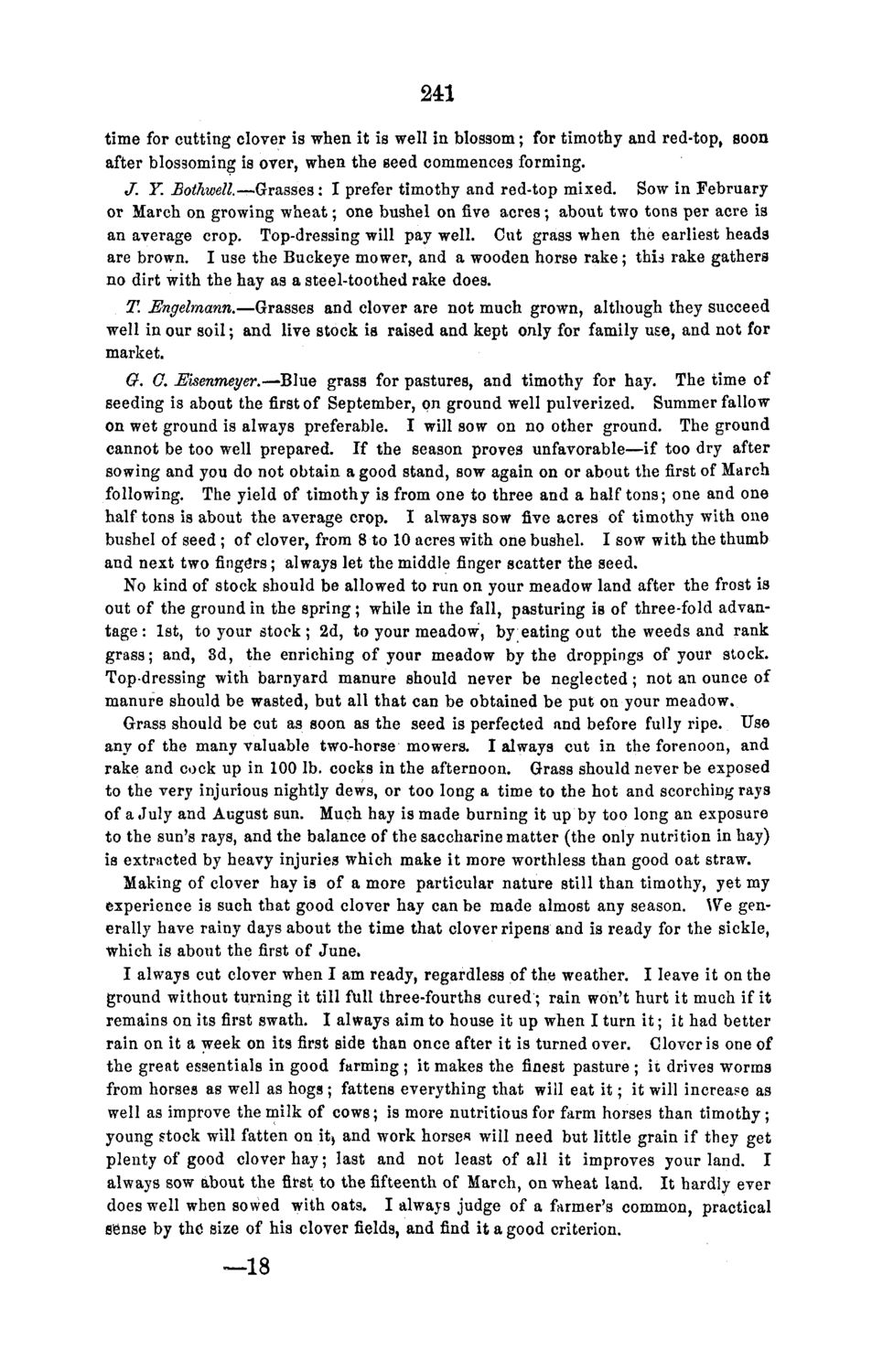| |
| |
Caption: Board of Trustees Minutes - 1868
This is a reduced-resolution page image for fast online browsing.

EXTRACTED TEXT FROM PAGE:
241 time for cutting clover is when it is well in blossom; for timothy and red-top, soon after blossoming is over, when the seed commences forming. J. Y. Bothwell—Grasses : I prefer timothy and red-top mixed. Sow in February or March on growing wheat; one bushel on five acres; about two tons per acre is an average crop. Top-dressing will pay well. Cut grass when the earliest heads are brown. I use the Buckeye mower, and a wooden horse rake; this rake gathers no dirt with the hay as a steel-toothed rake does. T. Engelmann.—Grasses and clover are not much grown, although they succeed well in our soil; and live stock is raised and kept only for family use, and not for market. G. C. Eisenmeyer.—'BluQ grass for pastures, and timothy for hay. The time of seeding is about the first of September, on ground well pulverized. Summer fallow on wet ground is always preferable. I will sow on no other ground. The ground cannot be too well prepared. If the season proves unfavorable—if too dry after sowing and you do not obtain a good stand, sow again on or about the first of March following. The yield of timothy is from one to three and a half tons; one and one half tons is about the average crop. I always sow five acres of timothy with one bushel of seed ; of clover, from 8 to 10 acres with one bushel. I sow with the thumb and next two fingers; always let the middle finger scatter the seed. No kind of stock should be allowed to run on your meadow land after the frost is out of the ground in the spring; while in the fall, pasturing is of three-fold advantage : 1st, to your stock ; 2d, to your meadow, by eating out the weeds and rank grass; and, 3d, the enriching of your meadow by the droppings of your stock. Top-dressing with barnyard manure should never be neglected; not an ounce of manure should be wasted, but all that can be obtained be put on your meadow. Grass should be cut as soon as the seed is perfected and before fully ripe. Use any of the many valuable two-horse mowers. I always cut in the forenoon, and rake and cock up in 100 lb. cocks in the afternoon. Grass should never be exposed to the very injurious nightly dews, or too long a time to the hot and scorching rays of a July and August sun. Much hay is made burning it up by too long an exposure to the sun's rays, and the balance of the saccharine matter (the only nutrition in hay) is extracted by heavy injuries which make it more worthless than good oat straw. Making of clover hay is of a more particular nature still than timothy, yet my experience is such that good clover hay can be made almost any season. We generally have rainy days about the time that clover ripens and is ready for the sickle, Which is about the first of June. I always cut clover when I am ready, regardless of the weather. I leave it on the ground without turning it till full three-fourths cured; rain won't hurt it much if it remains on its first swath. I always aim to house it up when I turn it; it had better rain on it a week on its first side than once after it is turned over. Clover is one of the great essentials in good farming ; it makes the finest pasture ; it drives worms from horses as well as hogs; fattens everything that will eat i t ; it will increase as well as improve the milk of cows; is more nutritious for farm horses than timothy; young stock will fatten on itj and work horses will need but little grain if they get plenty of good clover hay; last and not least of all it improves your land. I always sow about the first to the fifteenth of March, on wheat land. It hardly ever does well when sowed with oats. I always judge of a farmer's common, practical sense by the Size of his clover fields, and find it a good criterion. —18
| |